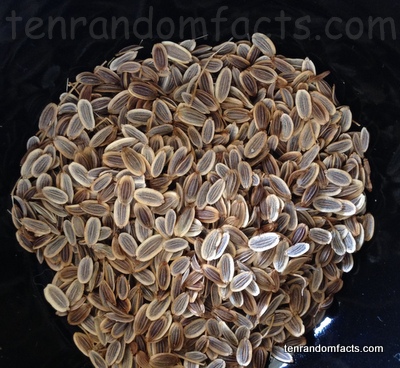Isn’t dill play-on-words fun!?
- Dill is a leafy herb that reaches heights of 40 to 60 centimetres (16 to 24 inches) and the plant is grown as an annual in full sun.
- Dill is native to Europe’s east, Russia’s south, Africa and the Mediterranean, and it is the only species in the Anethum genus; its scientific name is Anethum graveolens.
- Dill is from the family Apiaceae, that is also known as the Umbelliferae family, and it is the family of celery, parsley and carrots, and other hollow stem plants.
- ‘Dill’ is derived from the Norse word ‘dilla’, meaning ‘to lull’ or the Old English word ‘dile’, and the names are a reference to the plant’s medicinal purposes.
- Dill leaves are often used in seafood or soup dishes, as well as pickled items like cucumbers, and the seeds are used as a spice for flavouring.
 Seeds
Seeds
- Oil can be obtained from the dill plant, which can be used to produce soap.
- Dill has been used for thousands of years, and in England in the 5th to 11th centuries it was used to treat headaches, stomach illness, boils and nausea, and other sickness.
- Fresh dill leaves are delicate and feathery and are typically coloured a bright green, while seeds are mustard to brown in colour.
- Dill has a taste described typically as mild and warm, with a slight anise flavour, and the leaves have a milder flavour than the seeds.
- Dill leaves are a very good source of vitamin C and vitamin A, and they contain many other vitamins and minerals, while the seeds are high in calcium.
Bibliography:
Dill (Anethum graveolens), 2014, Gourmet Garden, http://www.gourmetgarden.com/en/herb/252/dill
Dill, 2014, The World’s Healthiest Foods, http://www.whfoods.com/genpage.php?tname=foodspice&dbid=71
Dill, 2014, Wikipedia, http://en.wikipedia.org/wiki/Dill





